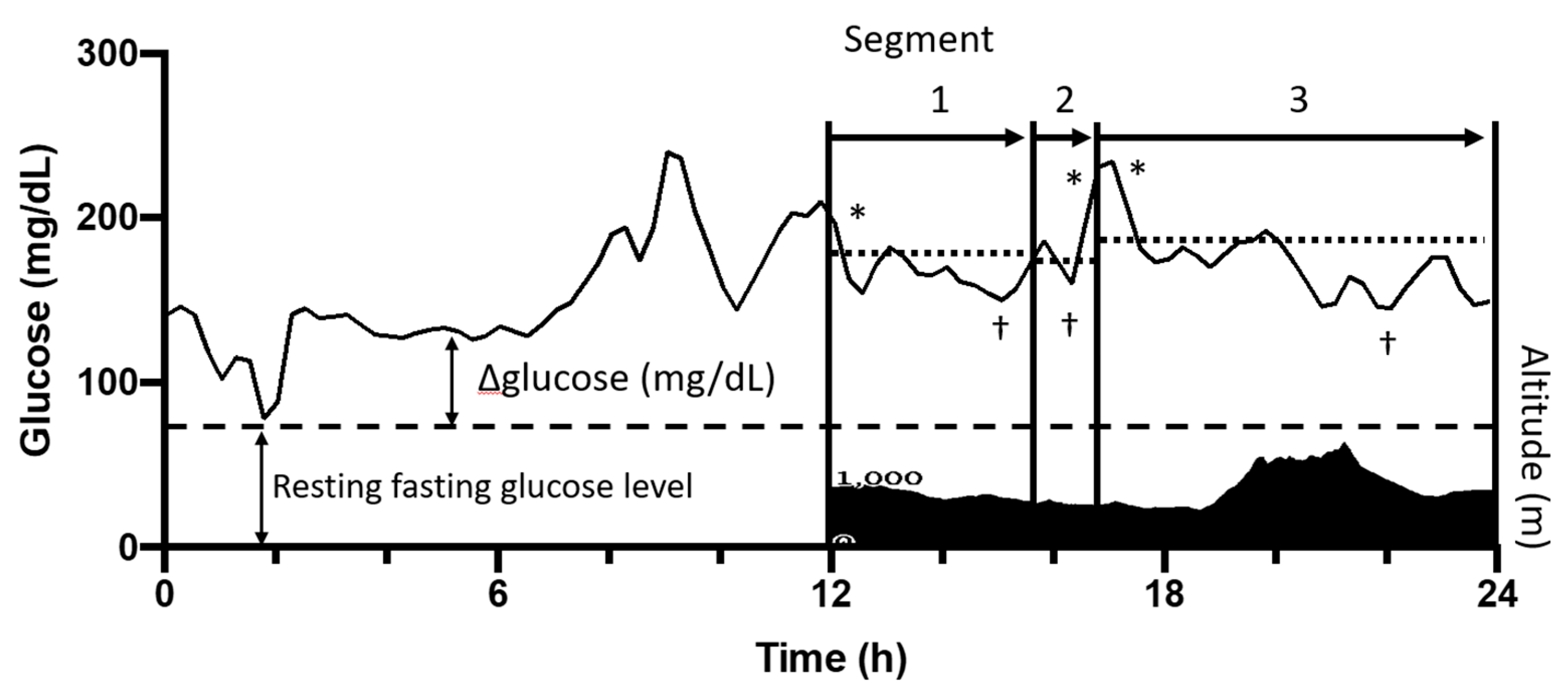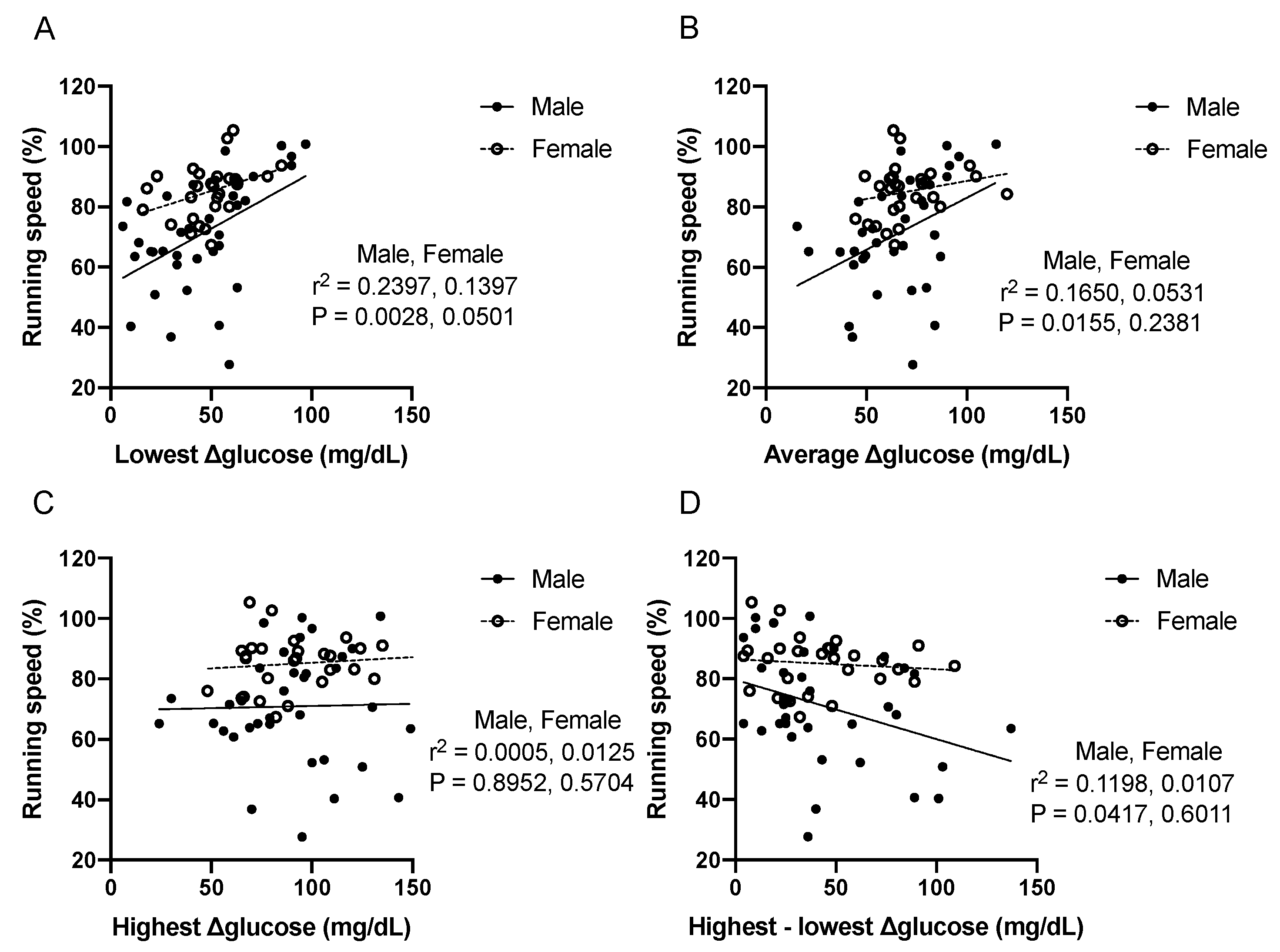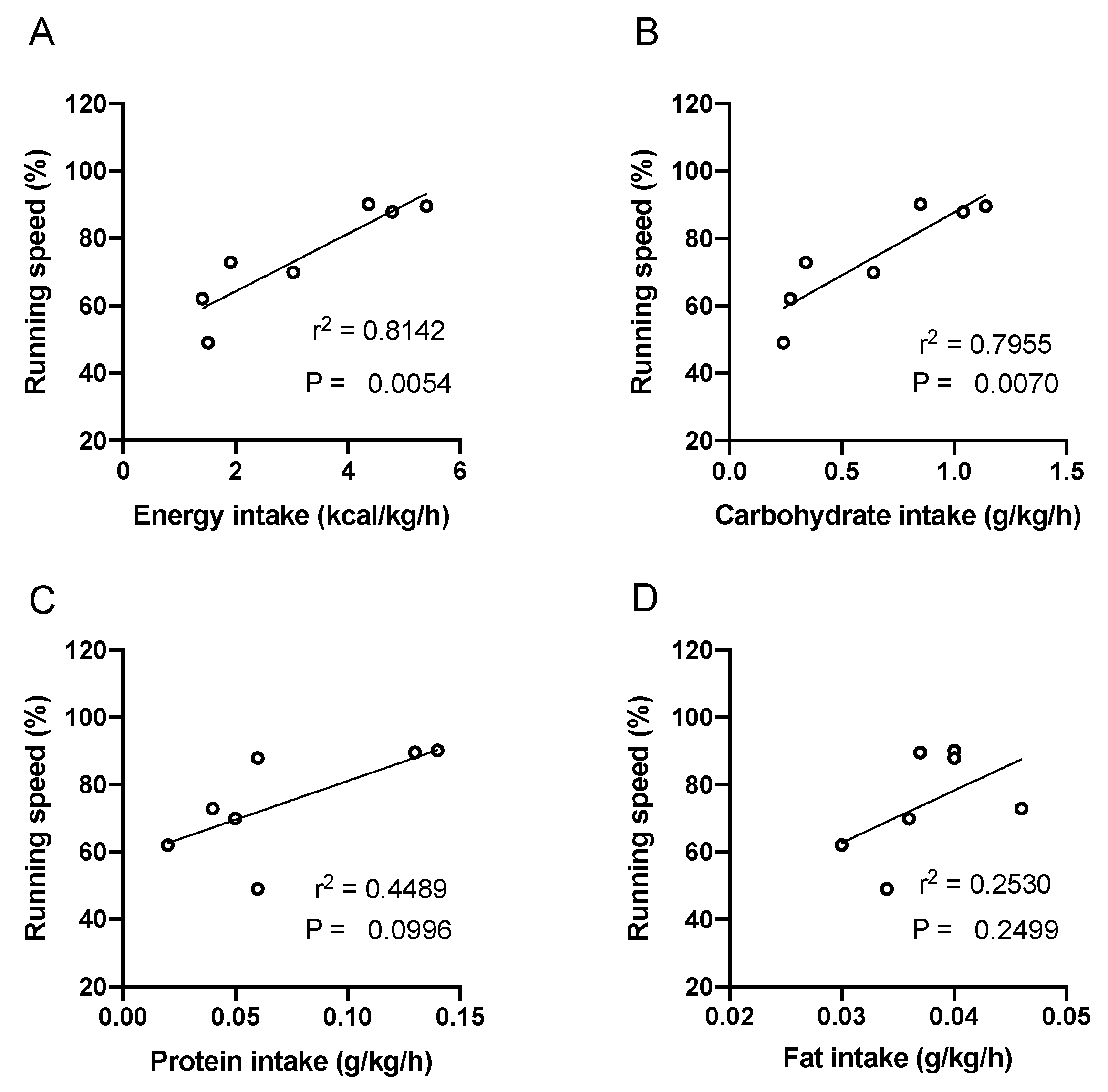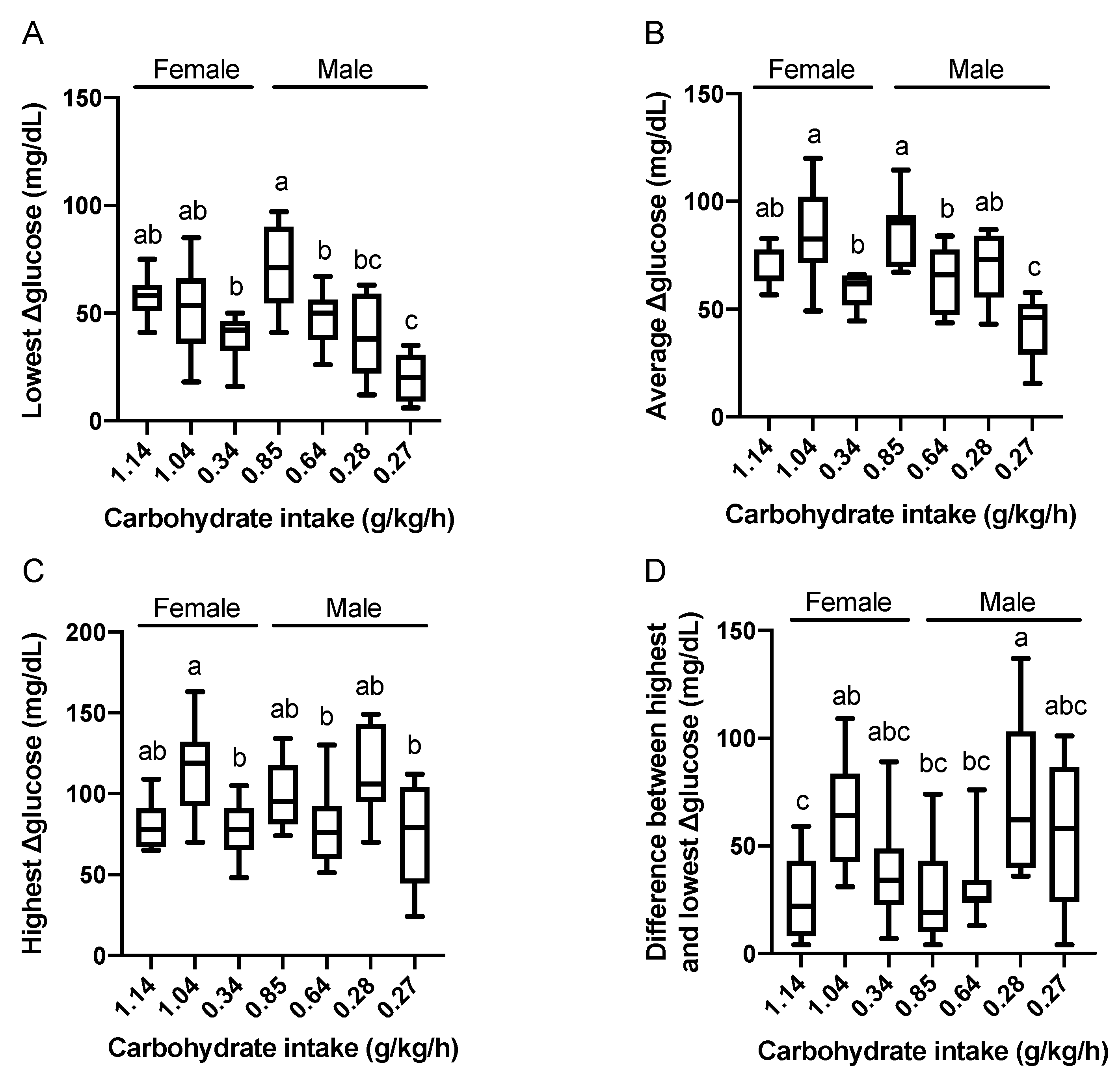Application of Continuous Glucose Monitoring for Assessment of Individual Carbohydrate Requirement during Ultramarathon Race
Abstract
1. Introduction
2. Materials and Methods
2.1. Study Design
2.2. Study Population
2.3. Race Course
2.4. Running Speed Data Collection and Standardization
2.5. Glucose Data Collection and Standardization
2.6. Diet Supply Data Collection
2.7. Statistics
3. Results
3.1. General Results
3.2. Relationship between Glucose Level and Running Speed
3.3. Relationship between Energy and Carbohydrate Intake and Running Speed
3.4. Relationship between the Amount of Carbohydrate Intake and Maintenance of Glucose Level during Race
4. Discussion
5. Conclusions
Author Contributions
Funding
Acknowledgments
Conflicts of Interest
References
- Jeukendrup, A.E. Carbohydrate intake during exercise and performance. Nutrition 2004, 20, 669–677. [Google Scholar] [CrossRef] [PubMed]
- Burke, L.M.; Hawley, J.A.; Wong, S.H.S.; Jeukendrup, A.E. Carbohydrates for training and competition. J. Sports Sci. 2011, 29, S17–S27. [Google Scholar] [CrossRef] [PubMed]
- Hawley, J.A.; Dennis, S.C.; Noakes, T.D. Oxidation of Carbohydrate Ingested During Prolonged Endurance Exercise. Sport. Med. An Int. J. Appl. Med. Sci. Sport Exerc. 1992, 14, 27–42. [Google Scholar] [CrossRef] [PubMed]
- Wagenmakers, A.J.M.; Brouns, F.; Saris, W.H.M.; Halliday, D. Oxidation rates of orally ingested carbohydrates during prolonged exercise in men. J. Appl. Physiol. 1993, 75, 2774–2780. [Google Scholar] [CrossRef]
- Nikolaidis, P.; Knechtle, B. Age of peak performance in 50-km ultramarathoners – is it older than in marathoners? Open Access J. Sport. Med. 2018, 9, 37–45. [Google Scholar] [CrossRef]
- Arribalzaga, M.; Ruano, M.; Saiz, S. Review of the Food Guidelines in Continuous Ultramarathon. J. Nutr. Food Sci. 2017, 7, 635. [Google Scholar]
- Pfeiffer, B.; Stellingwerff, T.; Hodgson, A.B.; Randell, R.; Pöttgen, K.; Res, P.; Jeukendrup, A.E. Nutritional intake and gastrointestinal problems during competitive endurance events. Med. Sci. Sports Exerc. 2012, 44, 344–351. [Google Scholar] [CrossRef]
- Wardenaar, F.C.; Dijkhuizen, R.; Ceelen, I.J.M.; Jonk, E.; de Vries, J.H.M.; Witkamp, R.F.; Mensink, M. Nutrient Intake by Ultramarathon Runners: Can They Meet Recommendations? Int. J. Sport Nutr. Exerc. Metab. 2015, 25, 375–386. [Google Scholar] [CrossRef]
- Tiller, N.B.; Roberts, J.D.; Beasley, L.; Chapman, S.; Pinto, J.M.; Smith, L.; Wiffin, M.; Russell, M.; Sparks, S.A.; Duckworth, L.; et al. International Society of Sports Nutrition Position Stand: Nutritional considerations for single-stage ultra-marathon training and racing. J. Int. Soc. Sports Nutr. 2019, 16, 1–23. [Google Scholar] [CrossRef]
- Williamson, E. Nutritional implications for ultra-endurance walking and running events. Extrem. Physiol. Med. 2016, 5, 13. [Google Scholar] [CrossRef]
- Pruitt, K.A.; Hill, J.M. Optimal pacing and carbohydrate intake strategies for ultramarathons. Eur. J. Appl. Physiol. 2017, 117, 2527–2545. [Google Scholar] [CrossRef]
- Stuempfle, K.J.; Hoffman, M.D.; Weschler, L.B.; Rogers, I.R.; Hew-Butler, T. Race diet of finishers and non-finishers in a 100 mile (161 km) mountain footrace. J. Am. Coll. Nutr. 2011, 30, 529–535. [Google Scholar] [CrossRef] [PubMed]
- Costa, R.J.S.; Gill, S.K.; Hankey, J.; Wright, A.; Marczak, S. Perturbed energy balance and hydration status in ultra-endurance runners during a 24 h ultra-marathon. Br. J. Nutr. 2014, 112, 428–437. [Google Scholar] [CrossRef]
- Costa, R.J.S.; Knechtle, B.; Tarnopolsky, M.; Hoffman, M.D. Nutrition for Ultramarathon Running: Trail, Track, and Road. Int. J. Sport Nutr. Exerc. Metab. 2019, 29, 130–140. [Google Scholar] [CrossRef] [PubMed]
- Al Hayek, A.A.; Robert, A.A.; Al Dawish, M.A. Evaluation of FreeStyle Libre Flash Glucose Monitoring System on Glycemic Control, Health-Related Quality of Life, and Fear of Hypoglycemia in Patients with Type 1 Diabetes. Clin. Med. Insights Endocrinol. Diabetes 2017, 10, 1–6. [Google Scholar] [CrossRef] [PubMed]
- Sengoku, Y.; Nakamura, K.; Ogata, H.; Nabekura, Y.; Nagasaka, S.; Tokuyama, K. Continuous Glucose Monitoring during a 100-km Race: A Case Study in an Elite Ultramarathon Runner. Int. J. Sports Physiol. Perform. 2015, 10, 124–127. [Google Scholar] [CrossRef] [PubMed]
- Fokkert, M.J.; Van Dijk, P.R.; Edens, M.A.; Abbes, S.; De Jong, D.; Slingerland, R.J.; Bilo, H.J.G. Performance of the freestyle libre flash glucose monitoring system in patients with type 1 and 2 diabetes mellitus. BMJ Open Diabetes Res. Care 2017, 5, e000320. [Google Scholar] [CrossRef]
- Fokkert, M.J.; Damman, A.; Van Dijk, P.R.; Edens, M.A.; Abbes, S.; Braakman, J.; Slingerland, R.J.; Dikkeschei, L.D.; Dille, J.; Bilo, H.J.G. Use of FreeStyle Libre Flash Monitor Register in the Netherlands (FLARE-NL1): Patient Experiences, Satisfaction, and Cost Analysis. Int. J. Endocrinol. 2019, 2019. [Google Scholar] [CrossRef]
- MEXT. Standard Tables of Food Composition in Japan-2015-(Seventh Revised Version); Ministry of Education: Tokyo, Japan, 2015.
- Arnaoutis, G.; Leveritt, M.; Wardenaar, F.C.; Hoogervorst, D.; Versteegen, J.J.; Van Der Burg, N.; Lambrechtse, K.J.; Bongers, C.C.W.G. Real-Time Observations of Food and Fluid Timing During a 120 km Ultramarathon. Front. Nutr. 2018, 5, 32. [Google Scholar]
- Clark, H.R.; Barker, M.E.; Corfe, B.M. Nutritional strategies of mountain marathon competitors—An observational study. Int. J. Sport Nutr. Exerc. Metab. 2005, 15, 160–172. [Google Scholar] [CrossRef]
- Hoffman, M.D.; Stuempfle, K.J. Hydration strategies, weight change and performance in a 161 km ultramarathon. Res. Sport. Med. 2014, 22, 213–225. [Google Scholar] [CrossRef] [PubMed]
- Zalcman, I.; Guarita, H.V.; Juzwiak, C.R.; Crispim, C.A.; Antunes, H.K.M.; Edwards, B.; Tufik, S.; de Mello, M.T. Nutritional status of adventure racers. Nutrition 2007, 23, 404–411. [Google Scholar] [CrossRef]
- Knechtle, B.; Nikolaidis, P.T. Physiology and pathophysiology in ultra-marathon running. Front. Physiol. 2018, 9, 634. [Google Scholar] [CrossRef]
- Stuempfle, K.J.; Valentino, T.; Hew-Butler, T.; Hecht, F.M.; Hoffman, M.D. Nausea is associated with endotoxemia during a 161-km ultramarathon. J. Sports Sci. 2016, 34, 1662–1668. [Google Scholar] [CrossRef] [PubMed]
- Brown, J.S.; Connolly, D.A. Selected human physiological responses during extreme heat: The Badwater Ultramarathon. J. strength Cond. Res. 2015, 29, 1729–1736. [Google Scholar] [CrossRef] [PubMed][Green Version]
- Martinez, S.; Aguilo, A.; Rodas, L.; Lozano, L.; Moreno, C.; Tauler, P. Energy, macronutrient and water intake during a mountain ultramarathon event: The influence of distance. J. Sports Sci. 2018, 36, 333–339. [Google Scholar] [CrossRef] [PubMed]
- Hill, R.J.; Davies, P.S. Energy expenditure during 2 wk of an ultra-endurance run around Australia. Med. Sci. Sports Exerc. 2001, 33, 148–151. [Google Scholar] [CrossRef]
- Dumke, C.L.; Shooter, L.; Lind, R.H.; Nieman, D.C. Indirect calorimetry during ultradistance running: A case report. J. Sports Sci. Med. 2006, 5, 692–698. [Google Scholar]
- David Cotter, J.; Gatterer, H.; Vernillo, G.; Savoldelli, A.; Skafidas, S.; Zignoli, A.; La Torre, A.; Pellegrini, B.; Giardini, G.; Trabucchi, P.; et al. An Extreme Mountain Ultra-Marathon Decreases the Cost of Uphill Walking and Running. Front. Physiol. 2016, 7, 530. [Google Scholar]
- Webster, C.C.; Noakes, T.D.; Chacko, S.K.; Swart, J.; Kohn, T.A.; Smith, J.A.H. Gluconeogenesis during endurance exercise in cyclists habituated to a long-term low carbohydrate high-fat diet. Authors. J. Physiol. C 2016, 594, 4389–4405. [Google Scholar] [CrossRef]
- Emhoff, C.A.W.; Messonnier, L.A.; Horning, M.A.; Fattor, J.A.; Carlson, T.J.; Brooks, G.A. Gluconeogenesis and hepatic glycogenolysis during exercise at the lactate threshold. J. Appl. Physiol. 2013, 114, 297–306. [Google Scholar] [CrossRef] [PubMed]
- Geer, E.B.; Shen, W. Gender differences in insulin resistance, body composition, and energy balance. Gend. Med. 2009, 6, 60–75. [Google Scholar] [CrossRef] [PubMed]
- Wismann, J.; Willoughby, D. Gender Differences in Carbohydrate Metabolism and Carbohydrate Loading. J. Int. Soc. Sports Nutr. 2006, 3, 28–35. [Google Scholar] [CrossRef] [PubMed]
- Soeters, M.R.; Sauerwein, H.P.; Groener, J.E.; Aerts, J.M.; Ackermans, M.T.; Glatz, J.F.C.; Fliers, E.; Serlie, M.J. Gender-related differences in the metabolic response to fasting. J. Clin. Endocrinol. Metab. 2007, 92, 3646–3652. [Google Scholar] [CrossRef]
- Keramida, G.; Peters, A.M. Fasting hepatic glucose uptake is higher in men than women. Physiol. Rep. 2017, 5, e13174. [Google Scholar] [CrossRef]
- Rehrer, N.J.; Beckers, E.J.; Brouns, F.; Ten Hoor, F.; Saris, W.H. Effects of dehydration on gastric emptying and gastrointestinal distress while running. Med. Sci. Sports Exerc. 1990, 22, 790–795. [Google Scholar] [CrossRef]
- Paton, C.D.; Hopkins, W.G. Tests of cycling performance. Sport. Med. 2001, 31, 489–496. [Google Scholar] [CrossRef]




| Male | Female | P | |
|---|---|---|---|
| Age (year) | 41.5 ± 6.2 | 42.6 ± 1.2 | 0.627 |
| Height (cm) | 172.9 ± 2.7 | 158.0 ± 6.5 | 0.019 |
| Weight (kg) | 66.0 ± 9.3 | 47.9 ± 3.8 | 0.036 |
| BMI (kg/m2) | 22.2 ± 2.8 | 18.9 ± 0.7 | 0.116 |
| Lean body mass (kg) | 56.3 ± 5.9 | 40.7 ± 4.3 | 0.012 |
| Fat mass (kg) | 22.2 ± 2.8 | 18.9 ± 0.7 | 0.116 |
| Subject | FS | 1 | 2 | 3 | MS | 4 | 5 | 6 | 7 | |
|---|---|---|---|---|---|---|---|---|---|---|
| Sex | F | F | F | M | M | M | M | M | ||
| Running speed | (%) | 100 | 89.5 | 87.9 | 72.9 | 100 | 90.1 | 70.0 | 62.0 | 49.0 |
| (min/km) | 6.37 | 5.70 | 5.60 | 4.64 | 8.01 | 7.22 | 5.60 | 4.96 | 3.90 | |
| Energy intake (kcal/kg/h) | - | 5.40 | 4.79 | 1.91 | - | 4.37 | 3.03 | 1.41 | 1.46 | |
| Carbohydrate intake (g/kg/h) | - | 1.14 | 1.04 | 0.34 | - | 0.85 | 0.64 | 0.27 | 0.28 | |
| Protein intake (g/kg/h) | - | 0.132 | 0.061 | 0.042 | - | 0.143 | 0.051 | 0.021 | 0.021 | |
| Fat intake (g/kg/h) | - | 0.037 | 0.040 | 0.046 | - | 0.040 | 0.036 | 0.030 | 0.029 | |
| Glucose (mg/dL) | ||||||||||
| During race | Average | - | 131 | 137 | 104 | - | 145 | 134 | 121 | 164 |
| SD | - | 11.9 | 30.2 | 15.0 | - | 20.4 | 20.2 | 22.9 | 30.5 | |
| Highest | - | 173 | 224 | 151 | - | 193 | 198 | 189 | 240 | |
| Lowest | - | 105 | 79 | 62 | - | 100 | 94 | 83 | 103 | |
| Resting fasting | - | 53 | 58 | 40 | - | 57 | 68 | 83 | 98 | |
| Subject | 1 | 2 | 3 | 4 | 5 | 6 | 7 | % of Total |
|---|---|---|---|---|---|---|---|---|
| Liquids and gels | 0.85 | 0.71 | 0.10 | 0.57 | 0.35 | 0.16 | 0.16 | 58. 8 ± 15.1 |
| Sports drink | 0.34 | 0.05 | 0.04 | 0.01 | 0.00 | 0.05 | 0.04 | 11.8 ± 10.8 |
| Cola | 0.00 | 0.08 | 0.00 | 0.05 | 0.03 | 0.06 | 0.02 | 6.9 ± 7.5 |
| Gel | 0.51 | 0.57 | 0.04 | 0.51 | 0.32 | 0.05 | 0.06 | 37.2±19.6 |
| Other liquid | 0.00 | 0.01 | 0.01 | 0.01 | 0.00 | 0.01 | 0.03 | 3.0 ± 4.3 |
| Fruits and sweets | 0.05 | 0.06 | 0.03 | 0.01 | 0.06 | 0.00 | 0.00 | 4.2 ± 3.7 |
| Fruit | 0.04 | 0.04 | 0.02 | 0.01 | 0.06 | 0.00 | 0.00 | 3.8 ± 3.5 |
| Sweet | 0.01 | 0.02 | 0.00 | 0.00 | 0.00 | 0.00 | 0.00 | 0.4 ± 0.7 |
| Solids | 0.24 | 0.27 | 0.21 | 0.27 | 0.23 | 0.10 | 0.12 | 37.0 ± 13.9 |
| Bar | 0.05 | 0.00 | 0.00 | 0.05 | 0.00 | 0.00 | 0.00 | 1.6 ± 2.7 |
| Noodle | 0.02 | 0.02 | 0.08 | 0.00 | 0.00 | 0.01 | 0.00 | 4.2 ± 8.1 |
| Bread | 0.00 | 0.05 | 0.05 | 0.01 | 0.04 | 0.04 | 0.03 | 7.9 ± 6.5 |
| Rice product | 0.00 | 0.19 | 0.09 | 0.18 | 0.15 | 0.04 | 0.08 | 18.9 ± 9.7 |
| Other solid | 0.17 | 0.01 | 0.00 | 0.04 | 0.03 | 0.01 | 0.00 | 4.4 ± 4.9 |
| Total | 1.14 | 1.04 | 0.34 | 0.85 | 0.64 | 0.27 | 0.28 |
© 2020 by the authors. Licensee MDPI, Basel, Switzerland. This article is an open access article distributed under the terms and conditions of the Creative Commons Attribution (CC BY) license (http://creativecommons.org/licenses/by/4.0/).
Share and Cite
Ishihara, K.; Uchiyama, N.; Kizaki, S.; Mori, E.; Nonaka, T.; Oneda, H. Application of Continuous Glucose Monitoring for Assessment of Individual Carbohydrate Requirement during Ultramarathon Race. Nutrients 2020, 12, 1121. https://doi.org/10.3390/nu12041121
Ishihara K, Uchiyama N, Kizaki S, Mori E, Nonaka T, Oneda H. Application of Continuous Glucose Monitoring for Assessment of Individual Carbohydrate Requirement during Ultramarathon Race. Nutrients. 2020; 12(4):1121. https://doi.org/10.3390/nu12041121
Chicago/Turabian StyleIshihara, Kengo, Natsuki Uchiyama, Shino Kizaki, Emi Mori, Tsutomu Nonaka, and Hiroshi Oneda. 2020. "Application of Continuous Glucose Monitoring for Assessment of Individual Carbohydrate Requirement during Ultramarathon Race" Nutrients 12, no. 4: 1121. https://doi.org/10.3390/nu12041121
APA StyleIshihara, K., Uchiyama, N., Kizaki, S., Mori, E., Nonaka, T., & Oneda, H. (2020). Application of Continuous Glucose Monitoring for Assessment of Individual Carbohydrate Requirement during Ultramarathon Race. Nutrients, 12(4), 1121. https://doi.org/10.3390/nu12041121






